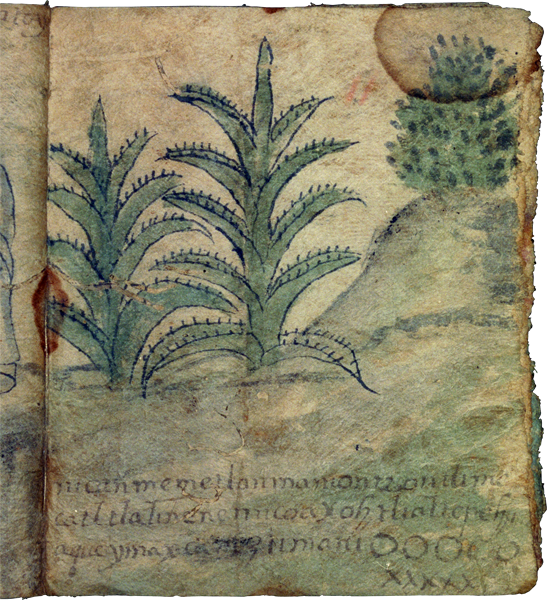f. 12r., entire face of one folio (pictorial and textual)
This page, which is the front side of the twelfth folio (12 recto) of eighteen folios, is typical of the image-heavy pages that feature landscapes included in these territorial claims of San Cristóbal Texcalucan and Santa María Magdalena Chichicaspa in the municipality of Huixquilucan (modern State of Mexico) late in the Spanish colonial period.
On this page we see a a hill or mountain on the right margin, with a small green tree on top. Closer to the viewer are two cacti, agaves, possibly magueyes. Their spines are very visible. The cacti are drawn in black ink and have a green watercolor wash. The tree has dots of black ink and a green wash. It may be an evergreen fir. The land surrounding the cacti is washed green, too.
The text on this page tells us that this is a place called Memetlan and there are two tzontli (2 x 400, or 800) mecatl (cords) of land.
A brown stain appears in the binding at about the middle of the page. Another, larger stain appears in the upper right corner.
página entera de un folio (pintura y texto)
Esta página, que es la parte delantera del folio doce (12 verso) de dieciocho folios, es típica de las páginas con imagen-pesada que documenta paisajes incluyendo estos reclamos territoriales de San Cristóbal Texcalucan y Santa María Magdalena Chichicaspa en el municipio de Huixquilucan (Estado de México) posteriormente en el período colonial Español.
En esta página vemos un cerro o montaña en el margen derecho, con un árbol pequeño encima. Cerca de la vista hay dos cacti, agaves, posiblemente magueyes. Sus espinas son muy visibles. Los cacti son dibujados en tinta negra y tienen un color verde pintado con acuarelas. El árbol tiene puntos de tinta negra y un poco de pintura verde. Puede ser un abeto de hoja perenne. La tierra que esta alrededor del cacti esta pintada en verde también.
El texto de esta página nos dice que este es un lugar llamado Memetian y que hay dos tzontli (2 x 400, o 800) mecati de tierra.
Una mancha cafe aparece en la cubierta en la mitad de la página. Otra mancha grande aparece en la esquina derecha de arriba.
